Cats playing versus fighting is a mystery cat owners struggle with, as the line between a fight and play is finely drawn. The difference between the two can be subtle, but it’s important to pay attention to their body language and vocalizations in order to maintain a peaceful environment. To prevent any potential conflicts, it’s crucial to closely monitor their interactions and intervene if necessary to ensure a harmonious household.
When cats engage in play fighting, it can be difficult for owners to tell if it’s harmless or potentially dangerous. This highlights the need for understanding subtle nuances in feline behavior in order to create a safe and peaceful environment for them.
Knowing a cat’s body language can help distinguish between playfulness and aggression. Relaxed postures and gentle swats indicate playfulness, while hissing and tension signify aggression.
Cats playing and mock-fighting are vital for their development, enhancing their hunting skills and overall well-being. Recognizing these behaviors is key to effective cat training and promoting positive social interaction.
Read on to unravel the mystery that is cat behavior before the claws really come out!
How Can We Better Understand Cat Play?
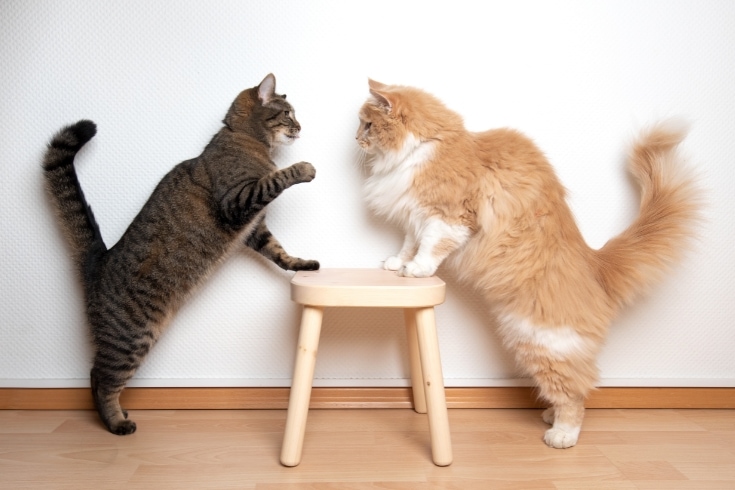
Understanding cat play behavior is important for their well-being and happiness. Play provides mental stimulation, exercise, bonding opportunities, and helps them practice hunting skills, explore their surroundings, and establish social hierarchies.
However, play can sometimes resemble fighting which concerns most of us. It concerns me for sure! Knowing the difference is essential for preventing injuries and fights.
General Cat Play Behavior
In cat play behavior, you’ll observe actions like chasing, pouncing, and batting at each other or objects. These are natural activities of a cat that’s playing and are simulating hunting behaviors that are instinctual to them. Playtime typically involves a lot of turn-taking between cats, where one cat pounces or chases, and then they trade roles.
During these moments, I always notice their body language is relaxed, tails may be up or wriggling about, and any vocalizations are usually soft or chirps that are light and non-aggressive.
Common Playful Actions in Cats
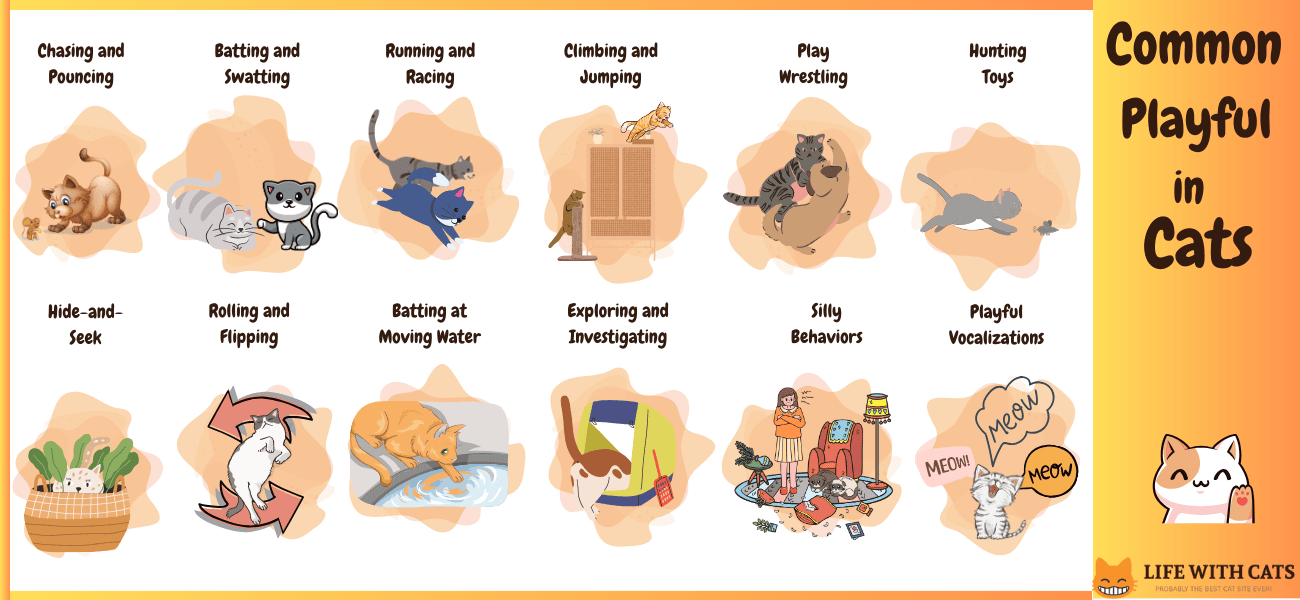
Building on what we know about cat play behavior, several actions signal play rather than aggression. You might see your cats engage in “air boxing,” where they stand on their hind legs and bat at each other without claws extended.
Another playful sign is the “play face,” where a cat’s ears are forward and expression is relaxed. They roll over on their backs as an invitation to engage in play (it’s a trap!), exposing their bellies but not defensively. Chasing and running signifies play, often with lots of movement of pauses that allow for turn-taking. Vocalizations during play are also less intense than those that are aggressive.
Significance of Play in a Cat’s Life
The significance of play in a cat’s life is extremely important and can’t be overstated. It’s very important for their mental, physical, and emotional well-being. Play behaviors serve multiple purposes, starting from kitten hood where it aids in the development of motor skills, coordination, and timing. As they grow, play becomes a natural outlet for their hunting instincts, which are deeply rooted in their DNA.
Play provides them with mental and social needs, and helps with depression and boredom. Socially, play helps to establish and maintain bonds between animals, humans, and other pets in the home.
Playtime can be an effective source of exercise, to help to manage their weight. So, understanding the role of play in a cat’s life will hopefully encourage you to engage in more activities with your kitty. Engaging with them actively by using tools such as toys, puzzles, and interactive games to enrich their lives can really strengthen your bond.
What Should I Know About Understanding Cat Fights?
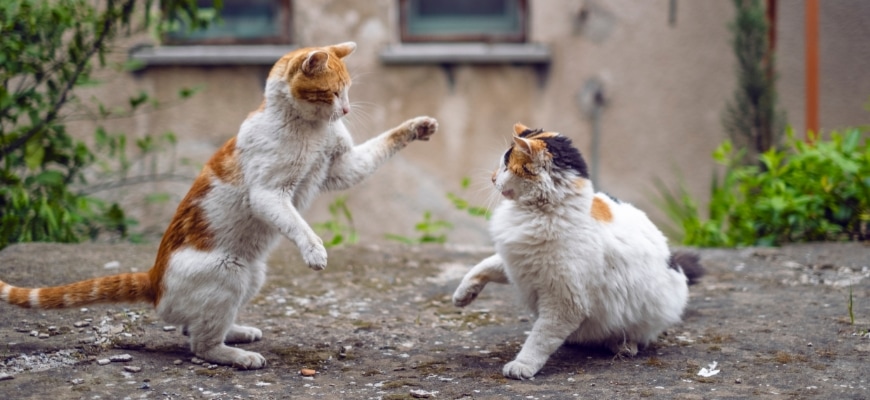
Understanding cat fights is just as important as understanding how cats play. Fights among cats lead to physical injuries, disrupt the social structure in the house, and may even escalate to where you need to take your cat(s) to the vet.
While some level of aggression is a natural expression of establishing territory or dominance, fighting that goes too far is not. Unlike play, fights are marked by more intense vocalizations like growling and hissing, and a heightened level of body language that’s more aggressive such as laid-back ears, growling, puffed-up fur, and extended claws.
Why do Cat’s Fight?
Cat fights can happen for various reasons, including territorial, competition for resources like food or a favorite sleeping spot, or that the social dynamics have shifted in the household which can cause tension.
Hormones play a factor in things, too. This is particularly true in unspayed or unneutered cats, as this can contribute to aggressive behaviors. Sometimes, changes in the house’s environment can cause issues such as a new pet or human in the house, and can trigger fights.
Common Signs of Cat Fights
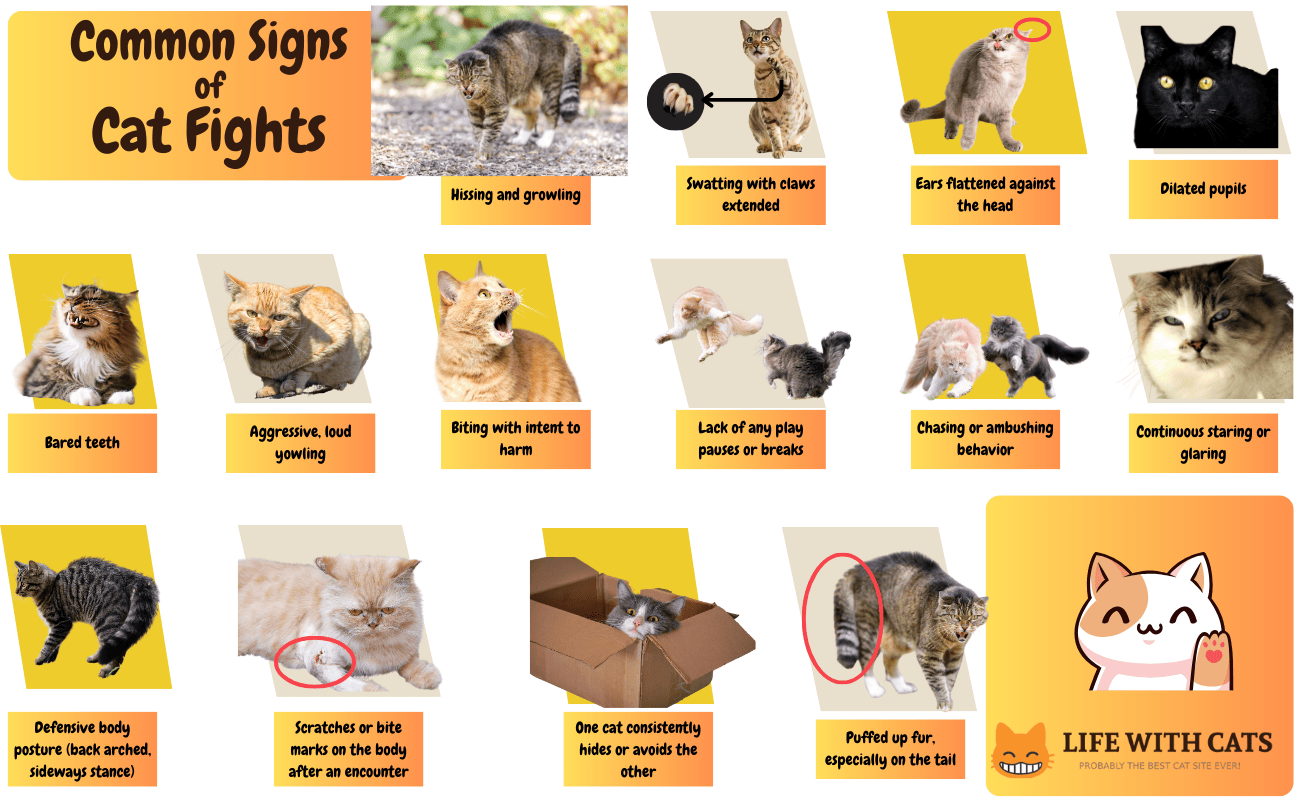
Being able to spot the signs of a real cat fight versus playful interaction is important for immediate intervention before someone gets hurt. Below are some common signs of fighting:
- Hissing and growling–hissing and growling are usually a clear sign of aggression or fear.
- Swatting with claws extended–swatting with claws extended is an action with intent to harm.
- Ears flattened against the head–this is a defensive position showing stress, fear, or aggression. In play, their ears are usually up and relaxed.
- Dilated pupils–while this can be excitement in context with the signs of aggression, it signals fear or aggression.
- Puffed up fur (especially on the tail)–cats puff up to make themselves look larger to predators, usually this is an intimidation factor.
- Bared teeth–exposing teeth is a sign of a threat or attack, different from closed play expressions.
- Aggressive yowling–this vocalization is not the softer meows and chirps you’ll hear during play. This often precedes a fight.
- Defensive body posture (sideways stance, arched back)–this is a clear indicator that a cat feels threatened.
- Continuous glaring or staring–to cats, prolonged eye contact is seen as a threat.
- Biting with intent to harm–Biting with intent to harm is more forceful and aims to injure.
- Chasing or ambushing behaviors–if one of your cats seems to relentlessly chase the other with no turn-taking.
- Lack of any play pauses or breaks–in play, cats will often pause or take breaks which are absent in fights.
- Scratches or bite marks on the body after an encounter–physical evidence of injury is a clear sign that the interaction between your cats was aggressive and not playful.
- One cat constantly hides from or avoids the other cat–if one cat seems to be in constant avoidance or is always hiding, this could show they feel threatened or have had a fight with the other.
Potential Risks and Consequences of Fights
Recognizing the signs of cat fights and intervening is important, not just to de-escalate the situation to prevent a wide range of negative consequences. Below are some problems and consequences that can arise from cat fights:
- Physical injuries such as scratches, bites, or wounds–these can lead to immediate pain, infection and require a vet’s treatment.
- Transmission of diseases like Feline Immunodeficiency Virus (FIV) or Feline Leukemia Virus (FeLV)–these serious diseases can be spread through bites and scratches and can pose long-term health effects.
- Development of abscesses from bite wounds–untreated bites can lead to painful abscesses that require medical attention.
- Stress and anxiety–repeated fights can lead to chronic stress and anxiety, affecting a cat’s mental health.
- Aggression issues developing over time–frequent fights can cause long-lasting behavioral issues.
- Behavioral patterns like inappropriate eliminating or over-grooming–stress from frequent fighting can show itself in behaviors such as urinating or pooping outside the litter box, or obsessive grooming.
- Development of fear or phobia–cats can develop a lasting fear of other animals or places with bad encounters.
- Risk of humans getting harmed while trying to separate a fight–cats may accidentally scratch or bite someone attempting to break up a fight.
- Decline in overall cat health because of chronic stress–persistent stress from recurring fights can lead to a decline in health and immunity.
- Potential disruption of household peace and harmony–consistent fighting not only stresses cats out, but can also create a tense situation for everyone involved.
What Are the Differences Between Cat Play and Cat Fights?
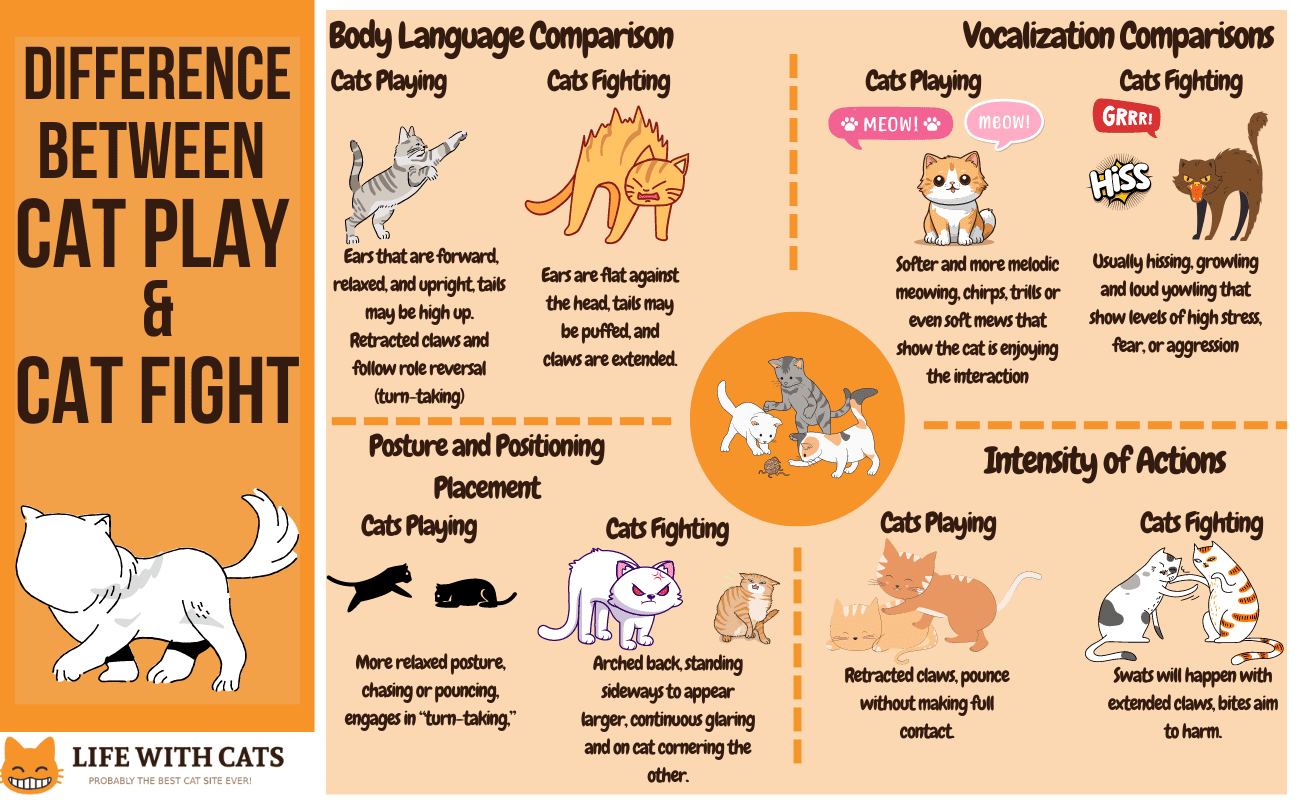
While both interactions can share similarities–like chasing, pouncing, and vocalizations–they are very different in their intent, signals, and potential outcomes. You’ll see signs such as flattened ears, loud vocalizations, and claws when a fight is about to ensue, for those times when play is in action, you’ll see a more relaxed posture, no claws and quieter mews and chirps.
Body Language Comparison
Body language is one of the most revealing things you can see, the differences between in fights and play. In play we’ll see relaxed body language such as relaxed ears that are forward, relaxed and upright, tails may be high up. Swats and pounces with play involve retracted claws and follow role reversal (turn-taking).
In comparison, the body language in a fight is tense and defensive, or aggressive. Ears are flat against the head, tails may be puffed up to make them look larger and more intimidating, and they usually extend claws when swatting or batting.
Vocalization Comparisons
Vocalizations are another way to tell between play and fighting. We often hear interactions in play as softer and more melodic meowing, chirps, trills or even soft mews that show the cat is enjoying the interaction.
In contrast, the vocalizations of fights are more intense and noticeable. You’ll usually hear hissing, growling and loud yowling that show levels of high stress, fear, or aggression. The vocalizations during a fight should intimidate and warn off an opponent, and serve as a signal to humans that intervention might be needed to prevent injuries.
Posture and Positioning Placement
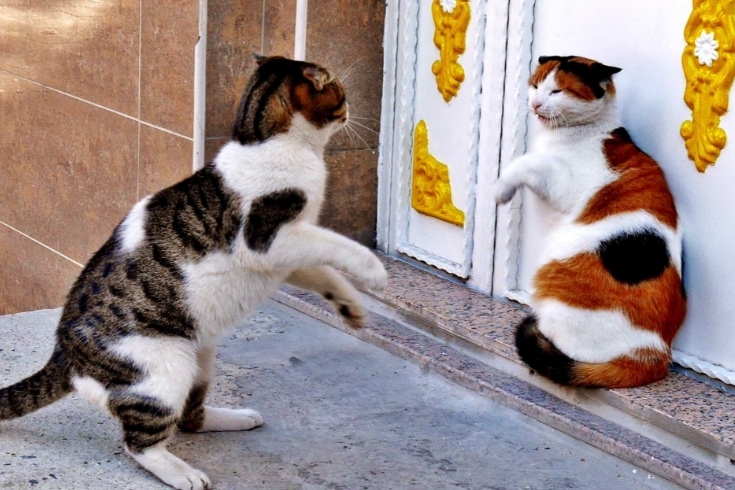
Understanding the nuances of posture and positioning placement can be your key to unlocking the puzzle of your cat’s behaviors. In play, the physical postures are more relaxed, often switching roles in activities such as chasing or pouncing. Playful cats may engage in “turn-taking,” where one cat assumes the more dominant position before they switch.
In a fight, the postures are tense and defensive or overly aggressive.
You might see one cat with an arched back, standing sideways to appear larger, which is a classic sign of defensive aggression. There might be continuous staring, and one cat might corner the other.
Intensity of Actions
One of the most telling factors in telling cat play from cat fights is the intensity in which the interactions are had. In a playful situation, movement is often exaggerated and can seem clumsy, with frequent breaks or pauses that allow for turn-taking. Cats may bat at each other with retracted claws, pounce without making full contact, or chase each other in a more lazy manner.
The actions in a fight are abrupt, swift, and highly focused, aimed at overpowering whomever they’re in a fight with. Swats will happen with extended claws, bites aim to harm, and chases look more like a pursuit than a game. The intensity leaves little room for any doubt that the situation is serious.
How Do I Safely Break Up a Cat Fight?
Safely breaking up a cat fight will need some care and careful attention. If you notice your cats fighting, break them up strategically by using things such as brooms, boxes, blankets, spray bottles, or anything else safe you can think of.
Never attempt to physically separate fighting cats (or any animals for that matter) with your hands or body, as heightened emotions can easily lead to scratches or bites aimed at you instead of the other animal or person.
Instead, try something like these options:
- Loud noises such as clapping your hands, banging pots or anything that can startle them.
- Throwing a blanket over the fighting cats can cause them to stop as this can temporarily pause the fight to make it safe to separate them.
- Use a broom to gently push them apart.
Once they’re separated, isolate the cats to different rooms so they have time to calm down. Your understanding of the situation and intensity of cat fights will let you judge the amount of intervention that needs to be had for everyone’s safety and well-being.
Precautions to Take When Intervening
Use tools or indirect methods such as loud noises or barriers to separate them. It’s also advised to wear protective gear like gloves and long sleeves. Always avoid direct physical contact while separating to avoid injury to yourself. Having dealt with a few cat fights, this is where I’ve needed to understand the intensity, body language, and vocalizations of cats in a fight becomes invaluable.
Here are some precautions to take when intervening in a cat fight:
- Stay Calm–it’s important to note here that animals can feel what you’re feeling and act on it. Staying calm is the most important part here to take when faced with fighting cats as your anxiety may cause the fight to escalate.
- Do Not Use Your Hands–do NOT use your hands to separate a cat fight as that can end up in injury. If you must do this because there isn’t anything else available, try to put on protective gear such as gloves and long sleeves.
- Use Distractions–sounds such as clapping, pots banging or causing any sort of distraction will pause the fight long enough to intervene.
- Separate With a Barrier–use a box, a broom, or anything else other than your hands to gently separate fighting cats.
- Use a Blanket or Towel–throwing a blanket or towel over the fighting cats will disorientate them momentarily to give you a chance to safely intervene.
- Never Reach for a Collar–this goes for dogs, too. Never reach for a cat’s collar as they can then redirect their aggression onto you as you’ll be close and handy!
- Check for Injuries–post-fight make sure that you’re checking for injuries such as scratches, bite marks (these can lead to an abscess so check carefully!), and other injuries. If there are any that seem bad or are a bite mark, please see your vet.
- Keep Cats Separated–post-fight or even before the fight if you know they will clash, keep the cats separated. You can do this by putting them in separate rooms, just don’t forget to provide them with their basic needs if they’re going to be in there a while.
- Consult a Vet–if your cat has injuries after a cat fight, or you’re not sure what’s causing the fights, consult a vet. They’ll be able to give you professional advice and see if there are any underlying causes.
Remember, it’s better to prevent fights than to have to break them up. If aggression becomes a recurring issue, consult a professional.
Tips for Safe Intervention
The following recommendations minimize risk to both you and your kitties while dealing with a fight.
- Avoid direct physical contact–never try to separate fighting cats (or any animal) using your hands or body.
- Using loud noises–clapping, banging pots, or using something that would startle them.
- Use barriers–use objects like brooms or large boards (boxes anyone?) to gently push the cats apart.
- Wear protective gear–if you think there’s a risk of injury, wear gloves, and long sleeves.
- Use a blanket or towel–throwing a blanket over the two cats will temporarily stop the fight long enough for you to intervene.
- Isolate cats after separation–once the cats are separated, put them in different rooms so they have time and space to calm down.
- Assess for injuries–after intervening, and the cats are calm, check both for any injuries that may require immediate attention. Pay special attention to bite marks.
What to do Post Fight
Once the fur has settled and cats are separated, the immediate aftermath of a fight is an important period that requires careful attention. Understanding cat fights, their signs, and intensity will be important in your actions post-fight.
It’s important to assess the condition of each cat, consider any needed vet care, and reevaluate the living arrangements or social dynamics that may have led to the fight.
Steps to Take Post-Fight
- Check for injuries
- Isolate the cats
- Consult a vet
- Observe behavioral changes
- Reassess living arrangements
- Consult a behaviorist
- Reintroduce gradually
By taking these steps post-fight, you’ll address the immediate concerns but also work towards getting the harmony and peace back into your house.
How do I Prevent Cat Fights?
To prevent a cat fight, a balanced play routine helps cats channel their energy constructively, reducing the possibility of aggression or territorial disputes. Prevention is always the cornerstone of keeping harmony and is always better than trying to cure something.
In this section I aim to equip you with proactive strategies to maintain peace.
Techniques to Encourage Safe Play
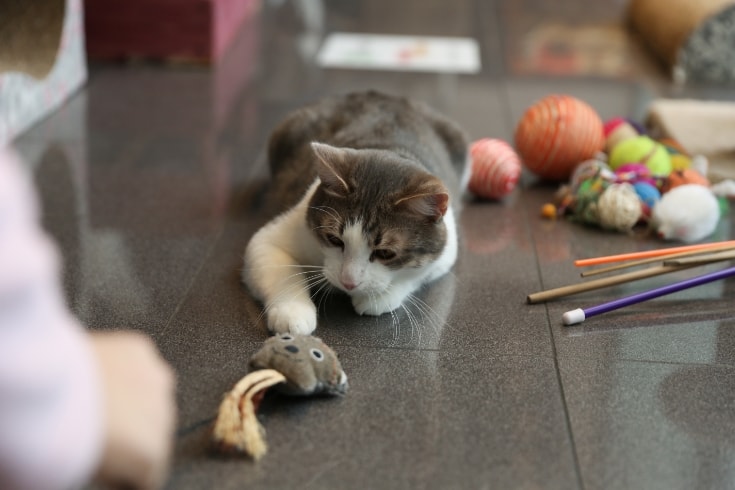
Below are some techniques you can use to encourage safe play.
- Scheduled playtime–consistent and scheduled playtimes can help cats understand when it’s time for fun, and when it’s time to relax.
- Use of toys–a variety of interactive toys can help mimic prey such as feather wands or laser pointers. This helps engage their hunting instincts.
- Rotate toys–rotate toys to keep the play exciting and new, reducing boredom that might lead to aggression.
- Personal space–make sure that each cat has its own territory. This means separate feeding stations, litter boxes, and beds.
- Multiple play areas–create multiple areas for your cats to play in so they can retreat to a safe space if they feel they need to.
- Turn-taking games–engage in games that encourage turn-taking, like passing a toy between two cats.
- Positive reinforcement–use treats and positive attention to reward good behavior and peaceful interactions.
- Observe and intervene–keep a close eye on your cats while they’re playing, especially if there’s a history of any aggression.
By using these techniques, you can promote safer play that allows your cats to use up energy without turning into aggression or fighting.
Role of Environment in Preventing Cat Fights
A poorly optimized space can become grounds for tension, territorial disputes, and fights. Optimizing your home based on an understanding of cat behavior, body language, and needs is important to prevent fights.
Environmental Adjustments to Prevent Cat Fights
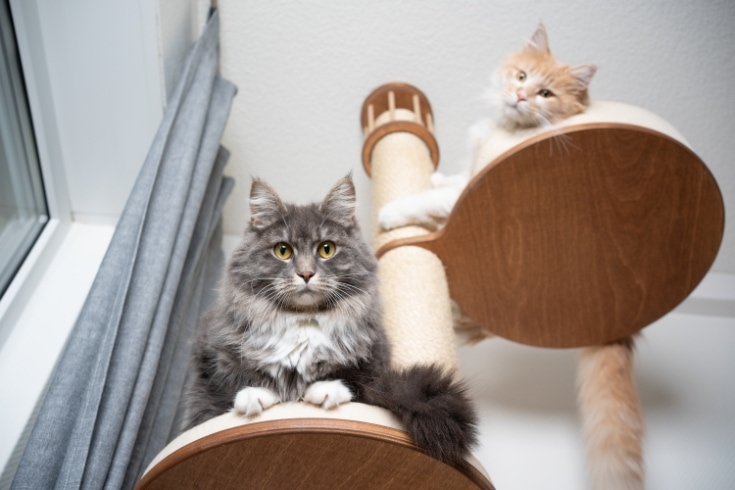
- Multiple resources–offer multiple feeding stations, litter boxes, and water bowls to lessen resource guarding
- Vertical space–use vertical spaces like shelves or cat trees to help with any territorial disputes.
- Separate territories–give specific areas or rooms as territories for each of your cats, especially if you notice they prefer to be alone.
- Safe zones–create safe zones with hiding spots, bedding, or calming pheromones where cats can retreat if they feel threatened or stressed.
- Interactive toys–place these in shared spaces to divert attention and encourage safe play.
- High-traffic areas–keep resources like food and litter boxes away from high-traffic areas where confrontations are more likely to happen.
When Do I Consult With a Professional?
You want to consult with a professional in cases of any aggression that goes too far. The time to seek out a professional is when you’re unsure if your cats are fighting or playing. These pros are great at pinpointing issues you might not see and can help distinguish between the two. They can also provide guidance on how to encourage healthy relationships and play in the household with your cats.
How Professionals Can Help
Professionals such as vets, pet behaviorists, and pet nutritionists can step in when conflicts among your cats become too much and a recurring issue that you can’t solve on your own.
From diagnosing underlying medical conditions or behavioral problems to providing personalized programs for training they can help with a variety of tools to get your house back to peace again.
Below are a few ways a professional can help you, ranging from behavior to medical issues.
- Behavior Assessment–professionals conduct an analysis of the cats’ interaction and triggers. This helps in identifying the distinction between play and fighting. They can also offer insights into underlying behavioral issues and causes of conflict.
- Medical Evaluation–essential to ruling out any underlying issues that might be causing aggressive behaviors, this can help with finding any hidden ailments a cat might be experiencing. Vets can ensure conditions, such as those like hormone imbalance, aren’t what are causing the fights.
- Behavior Modification Plans–tailored strategies for your specific household that employ techniques such as positive reinforcement and environmental adjustments which aims to reduce and redirect negative behaviors.
- Medication Management–in some cases medication may be necessary to reduce any aggression or anxiety. Professionals will prescribe and guide you on dosage, when to give, and what the medications purpose is. It’s important to note here that medication is not a cure all, there will need to be other modifications, too.
- Education–professionals provide insights and training to cat owners based on knowledge about specific triggers, preventative measures and help owners to understand and respond better to their cats’ needs.
- Monitoring and Follow-Up–observation post-intervention and adjustments with regular check-ins can help to get feedback and address any recurring issues so effective strategies can be put in place.
Importance of Professional Advice in Understanding Cat Behavior
The complexity of the feline social system, body language, and individual temperaments can sometimes require the insights of a trained professional. Their expertise can fill the gaps in your understanding and provide you with a more comprehensive picture of what’s going on.
Reasons Why Professional Advice is Important
- Objective analysis–an unbiased viewpoint to identify triggers or behavioral patterns you may not see.
- In-depth knowledge–a deep understanding of feline psychology, helping you understand not just what your cats are doing, but why they’re doing it.
- Tailored solutions–general advice doesn’t apply to every cat, so professionals can provide personalized recommendations based on your situation.
- Early intervention–timely advice from a professional can prevent minor issues from turning into a severe problem like aggression.
- Holistic approach–they may consider multiple aspects like medical history, environment, and even interactions with human family members.
- Resources for special cases–if your cat has a medical condition or special needs, a professional can offer guidance that you won’t find in most general cat care guidelines.
- Long-term strategy–advice often includes ongoing measures, not just immediate solutions.
FAQ
Can cat play escalate into a fight?
Yes, cat play can sometimes escalate into a fight, especially if one cat becomes overstimulated or if there are any underlying tensions between the cats.
Is it normal for cats to fight?
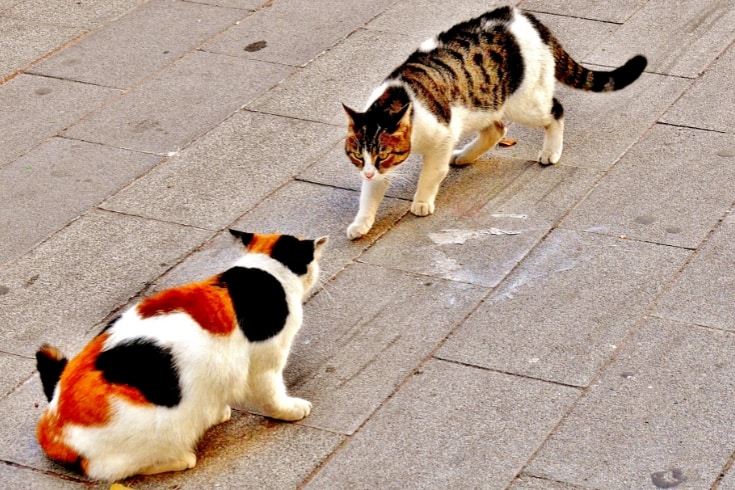
Occasional disputes are normal in multi-cat households, but frequent fights are a cause for concern and might require intervention.
Should I intervene when my cats are fighting?
Yes, intervene if a fight becomes violent or one cat appears to be in distress, but make sure you take precautions to protect yourself when doing so.
Can cats that fight ever learn to get along?
Yes, with proper intervention and behavioral training, many cats that fight can learn to live together peacefully or even become friends!
How can I introduce a new cat to my existing cat without causing fights?
Introduce them gradually, starting with scent swapping and controlled, brief encounters in a neutral space. Slowly extend the time they spend together as they grow more comfortable with one another.
Are certain breeds of cats more likely to fight?
While temperament varies from cat to cat, certain breeds like the Siamese are more vocal and assertive, which could potentially lead to fights in a multi-cat household.
Can cat fights have a psychological effect on cats?
Yes, frequent fights can cause stress, anxiety, and behavioral changes in cats. This affects their well-being and potentially leads to long-term issues.
Can change in my home environment influence whether my cats play or fight?
Yes, changes in the environment like adding new furniture, changing a cat’s routine, or even rearranging their feeding area can create stress, possibly causing fights.
Armed with these answers, I hope you’ll be better prepared to understand and manage your cat’s social life, whether they’re inclined to play or fight.
Conclusion
Being able to differentiate between playing and fighting through body language, vocalizations, and context helps you intervene appropriately and minimize any risks. Consulting professionals and changing the environment can improve the quality of life for your cats and everyone involved.
This isn’t just about preventing fights; it’s about creating an enriching environment where you and your cats can thrive. With the knowledge and tools I’ve outlined in this guide, you should be well-equipped to navigate the world of cat behavior and have a peaceful home.